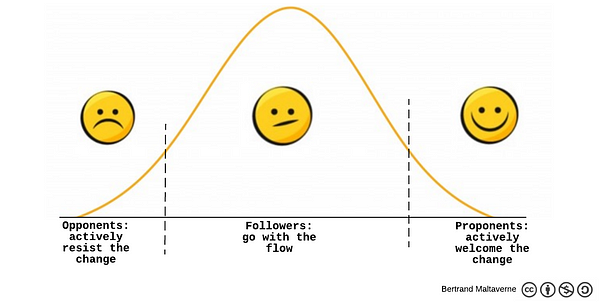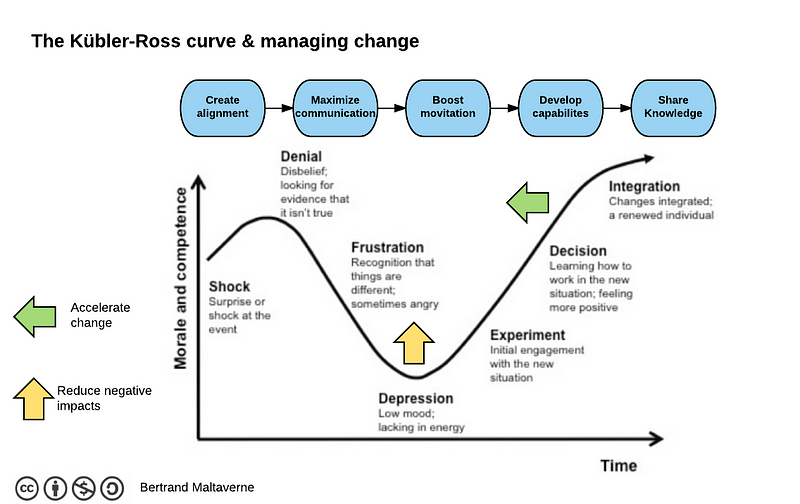This last post on the series on the adoption of Procurement technology will highlight what actually happens during a change. It is only with a good understanding of these aspects that change leaders can conduct fruitful and lasting change initiatives.

Source: The five stages of grief, The Elisabeth Kubler-Ross Foundation
Because changes are also about grievance and loss, the simplified version of the model is often used in change management. The steps, at a high level, are:
- Denial: People reject the change. You hear things like “it will not work here” or “we have already tried”,…
- Anger: People understand that the change is coming. They can become angry and bitter: “what a waste of time”, “there are other things with a higher priority”.
- Bargaining: This is where a dialog starts as people try to negotiate the change to find a compromise or a way out. Some blackmailing is possible in this phase: “OK, but this means that I will have less time for other activities…”
- Depression: People understand the gap and only see the “half-empty” glass, that is, how much they have to adapt. Some may think that they will never make it. People also are much more passive about the change.
- Acceptance: People start by giving the change a try, or to test it. They realize that “things are not so bad after all.” After experimenting, they accept and move-on: “I can now see how the change made things better!”.
Change at work is about changing the way people do things. IT means that people have to unlearn what they have been doing for years to learn new things. This can be very traumatic as they move from “unconscious incompetence” to “unconscious competence” in the learning cycle:
- Stage 1 = Unconscious incompetence: “I don’t know that I don’t know how to do this.” People are not yet aware of the need to change (status quo).
- Stage 2 = Conscious incompetence: “I know that I don’t know how to do this, yet.” This is when the need for change is revealed and it explains the denial, anger, and depression phases.
- Stage 3 = Conscious competence: ”I can do this when I focus.” This is the beginning of the acceptance.
- Stage 4 = Unconscious competence: “This is second nature to me!” It is full adoption and integration of the change.
The above explains why, at first, a change represents a threat to people. This also explains why the first steps are very intense in terms of objections. Then, slowly but steadily, people move forward to the stage of “conscious competence”. People do new things but with a conscious effort, the new “how” is not yet a reflex. After some time, they reach the last level, doing new things without even realizing it.

The change curve is useful for change leaders to put reactions into context.
Initial reactions can be hard on the people in charge a project. Anger, objections, negativity are all normal. Nothing personal!
The bell curve…

Based on experience, a population of people facing a change can be broken down into three categories:
- 25% actively resist the change
- 50% of the people are passive
- 25% welcome it
The percentages are indicative and should not be taken too directly. The central message is that a majority of people are passive and will follow whoever between the proponents or opponents win! It is an important and critical factor to have in mind as, too often, too much time is dedicated to convincing everybody. It costs a lot of time and effort, and is not effective. Instead, it is more important to focus on the proponents because:
- they are the key to getting the middle 50% onboard,
- the chance to convince everybody is very low.
Adoption is the true purpose of implementation projects. Putting in place a new piece of technology that no one uses brings nothing. It is only possible to create adoption with a particular approach and specific activities at all stages of the project: before, during, and after.
For example, specific roles in the organization have to support the project and the change. Besides the typical project governance (Sr. Managers, Sponsors…) which I will not describe here, it is important to also have:
- Champions (people belonging to the proponents): users who will be able to test, in real conditions, the system. They will provide constructive feedback (and are more understanding of glitches at the beginning). They are also the ones who will put the followers in motion,
- Super/Key Users: users with a greater business and tool knowledge who can help the project team refine the projects and the use of the solution. They can also have a role of support and training in their respective business areas making widespread roll-out and adoption easier and faster,
- A complete support structure that will be there when users (internal and external) need help and to onboard new users (providers provide a technical hotline, an organization’s own support team adds business knowledge to the support activities.
- A governance that, once in run mode, will manage the solution from a business standpoint and a technical perspective (it also includes the management of the relation with the provider).
Also, the design of the solution has to be a facilitator of the onboarding of new users. It is why ease-of-use, user-friendliness, and adaptability (activating advanced features at a later stage) are important.
All the above has the purpose of managing change by accelerating the change and fostering adoption (cementing the change) by having the appropriate response during all phases of the project and all stages of the change:

Insanity: doing the same thing over and over again and expecting different results.”
– Albert Einstein
Article by channel:
Everything you need to know about Digital Transformation
The best articles, news and events direct to your inbox
Read more articles tagged: Change & Transformation, Featured






